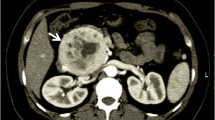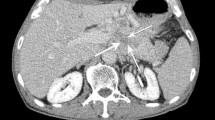Abstract
Background
Prognostic indicators of the malignant potential of pancreatic neuroendocrine tumors (PNET) are limited. We assessed tumor shape and enhancement pattern on contrast-enhanced computed tomography as predictors of malignant potential.
Methods
Sixty cases of PNET patients undergoing curative surgery from 2001 to 2014 were enrolled onto our retrospective study. Preoperative enhanced CTs were assessed, and criteria defined for regularly shaped and enhancing tumors (group 1), and irregularly shaped and/or enhancing tumors (group 2). The relation of tumor shape and enhancement pattern to outcome was assessed.
Results
Interobserver agreement was substantial (kappa = 0.74). Group 2 (n = 24) was significantly correlated with synchronous liver metastasis (23 vs. 0 %), lymph node metastasis (36 vs. 3 %), pathologic capsular invasion (68 vs. 8 %), larger tumor size (30 vs. 12 mm), tumor, node, metastasis classification system (TNM) stage III/IV disease (46 vs. 3 %), and histologic grade 2/3 (41 vs. 0 %). Multivariate analysis revealed that tumor grade 2/3 and group 2 criteria correlated with tumor relapse (hazard ratio 6.5 and 13.6, P = 0.0071 and 0.039, respectively), and that only group 2 criteria were independently correlated with poor overall survival (hazard ratio 5.56e + 9, P = 0.0041).
Conclusions
Irregular tumor shape/enhancement on preoperative computed tomography is a negative prognostic factor after curative surgery for PNET.

Similar content being viewed by others

References
Franko J, Feng W, Yip L, Genovese E, Moser AJ. Non-functional neuroendocrine carcinoma of the pancreas: incidence, tumor biology, and outcomes in 2158 patients. J Gastrointest Surg. 2010;14:541–8.
Yao JC, Eisner MP, Leary C, Dagohoy C, Phan A, Rashid A, et al. Population-based study of islet cell carcinoma. Ann Surg Oncol. 2007;14:3492–500.
Kimura W, Kuroda A, Morioka Y. Clinical pathology of endocrine tumors of the pancreas. analysis of autopsy cases. Dig Dis Sci. 1991;36:933–42.
Ito T, Lee L, Hijioka M, Kawabe K, Kato M, Nakamura K, et al. The up-to-date review of epidemiological pancreatic neuroendocrine tumors in Japan. J Hepatobiliary Pancreat Sci. 2015;22:574–7.
Yao JC, Hassan M, Phan A, Dagohoy C, Leary C, Mares JE, et al. One hundred years after “carcinoid”: epidemiology of and prognostic factors for neuroendocrine tumors in 35,825 cases in the United States. J Clin Oncol. 2008;26:3063–72.
Birnbaum DJ, Turrini O, Vigano L, Russolillo N, Autret A, Moutardier V, et al. Surgical management of advanced pancreatic neuroendocrine tumors: short-term and long-term results from an international multi-institutional study. Ann Surg Oncol. 2015;22:1000–7.
Panzuto F, Boninsegna L, Fazio N, Campana D, Pia Brizzi M, Capurso G, et al. Metastatic and locally advanced pancreatic endocrine carcinomas: analysis of factors associated with disease progression. J Clin Oncol. 2011;29:2372–7.
Ito T, Igarashi H, Jensen RT. Therapy of metastatic pancreatic neuroendocrine tumors (pNETs): recent insights and advances. J Gastroenterol. 2012;47:941–60.
Ekeblad S, Skogseid B, Dunder K, Oberg K, Eriksson B. Prognostic factors and survival in 324 patients with pancreatic endocrine tumor treated at a single institution. Clin Cancer Res. 2008;14:7798–803.
Bettini R, Boninsegna L, Mantovani W, Capelli P, Bassi C, Pederzoli P, et al. Prognostic factors at diagnosis and value of WHO classification in a mono-institutional series of 180 non-functioning pancreatic endocrine tumours. Ann Oncol. 2008;19:903–8.
Viera AJ, Garrett JM. Understanding interobserver agreement: the kappa statistic. Family Med. 2005;37:360–3.
Ito T, Igarashi H, Jensen RT. Pancreatic neuroendocrine tumors: clinical features, diagnosis and medical treatment: advances. Best Pract Res Clin Gastroenterol. 2012;26:737–53.
Modlin IM, Oberg K, Chung DC, Jensen RT, de Herder WW, Thakker RV, et al. Gastroenteropancreatic neuroendocrine tumours. Lancet Oncol. 2008;9:61–72.
Tomimaru Y, Eguchi H, Tatsumi M, Kim T, Hama N, Wada H, et al. Clinical utility of 2-[(18)F] fluoro-2-deoxy-d-glucose positron emission tomography in predicting World Health Organization grade in pancreatic neuroendocrine tumors. Surgery. 2015;157:269–76.
Hyodo R, Suzuki K, Ogawa H, Komada T, Naganawa S. Pancreatic neuroendocrine tumors containing areas of iso- or hypoattenuation in dynamic contrast-enhanced computed tomography: spectrum of imaging findings and pathological grading. Eur J Radiol. 2015;84:2103–9.
Takumi K, Fukukura Y, Higashi M, Ideue J, Umanodan T, Hakamada H, et al. Pancreatic neuroendocrine tumors: correlation between the contrast-enhanced computed tomography features and the pathological tumor grade. Eur J Radiol. 2015;84:1436–43.
Jiao Y, Shi C, Edil BH, de Wilde RF, Klimstra DS, Maitra A, et al. DAXX/ATRX, MEN1, and mTOR pathway genes are frequently altered in pancreatic neuroendocrine tumors. Science. 2011;331:1199–203.
Zhang J, Francois R, Iyer R, et al. Current understanding of the molecular biology of pancreatic neuroendocrine tumors. J Natl Cancer Inst. 2013;105:1005–17.
Yuan F, Shi M, Ji J, Shi H, Zhou C, Yu Y, et al. KRAS and DAXX/ATRX gene mutations are correlated with the clinicopathological features, advanced diseases, and poor prognosis in Chinese patients with pancreatic neuroendocrine tumors. Int J Biol Sci. 2014;10:957–65.
Yao JC, Shah MH, Ito T, Bohas CL, Wolin EM, Van Cutsem E, et al. Everolimus for advanced pancreatic neuroendocrine tumors. N Engl J Med. 2011;364:514–23.
Raymond E, Dahan L, Raoul JL, Bang YJ, Borbath I, Lombard-Bohas C, et al. Sunitinib malate for the treatment of pancreatic neuroendocrine tumors. N Engl J Med. 2011;364:501–13.
Disclosure
The authors declare no conflict of interest.
Author information
Authors and Affiliations
Corresponding author
Electronic supplementary material
Below is the link to the electronic supplementary material.
Rights and permissions
About this article
Cite this article
Okabe, H., Hashimoto, D., Chikamoto, A. et al. Shape and Enhancement Characteristics of Pancreatic Neuroendocrine Tumor on Preoperative Contrast-enhanced Computed Tomography May be Prognostic Indicators. Ann Surg Oncol 24, 1399–1405 (2017). https://doi.org/10.1245/s10434-016-5630-4
Received:
Published:
Issue Date:
DOI: https://doi.org/10.1245/s10434-016-5630-4



